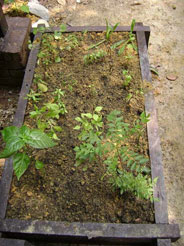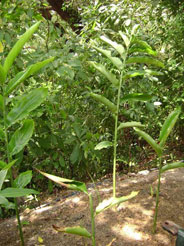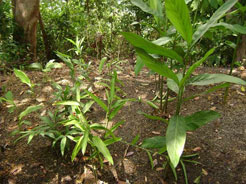
|
||
|
Follow @Nazlina
Malay herbs gardenMalay herbs garden can be grown easily. Most of the seedlings or cuttings are readily available. What you need is just space. Ideally, you should have a backyard. Some of the herbs can grow in small pots but some require fertile land and plenty of space to grow.
I really love to be able to pick up fresh herbs out of their plants just before cooking. The smell and taste are truly wonderful. Malaysia is truly blessed with fertile land and also all year round tropical weather. During rainy season, even an unkempt garden will run riot with fragrant leaves of various herbs. For an avid horticulturist, Malay herbs garden will give a lot of satisfaction. Besides saving cost, home grown Malay herbs are free from harmful insecticide. You can even monitor the fertilizer being used to be totally organic. Usage of fresh herbs makes your cooking need less oil or salt because they help to bring out the natural flavor of other ingredients. The smell is more intense, the taste is sharper. So, you get healthier meals. Besides, the herbs also have a lot of beneficial properties such as anti-oxidants and vitamins that help drive free radical away. Your nasi lemak will be so nice with fresh ginger and pandanus leaves, your nasi kerabu will smack of goodness with finely julienned ulam and your Thai influenced dishes would fill your kitchen with tantalizing smells. Many types of herbs can planted. Most of them also grow very quickly. Green fingers are not truly needed. Given enough good soil, water and sunlight, these herbs flourish.
Here is the list of herbs, tubers and also spices you can grow in your garden:
Other than herbs, plants or trees that are always useful to have in your Malay herbs garden (all of us are wishing for larger backyard, or even a whole orchard) are:
For leafy herbs, you need good drainage and plenty of sunlight. For tuber, soil with clay is preferable. Bigger trees need more time to grow and bear fruit. So, what are you waiting for? Get dirty and start digging to plant your Malay herbs! Gardening is truly a therapeutic and rewarding past time. Back to the page of Usage of Spices

Custom Search
|

Custom Search
Nazlina's Cooking Class in PenangAttend my cooking class to learn making traditional food.
The morning class includes Penang Market Tour.
PLEASE NOTE: We now offer PM classes, for vegan and vegetarians. |
|
|
|
||
|
|
||

 Some of the herbs need plenty of water, so you can grow it next to a running
brook or artificial water feature (like pandanus). Or, even in a very big
terracotta pot.
Some of the herbs need plenty of water, so you can grow it next to a running
brook or artificial water feature (like pandanus). Or, even in a very big
terracotta pot.  Sweet potato
Sweet potato


New! Comments
Have your say about what you just read! Leave me a comment in the box below.